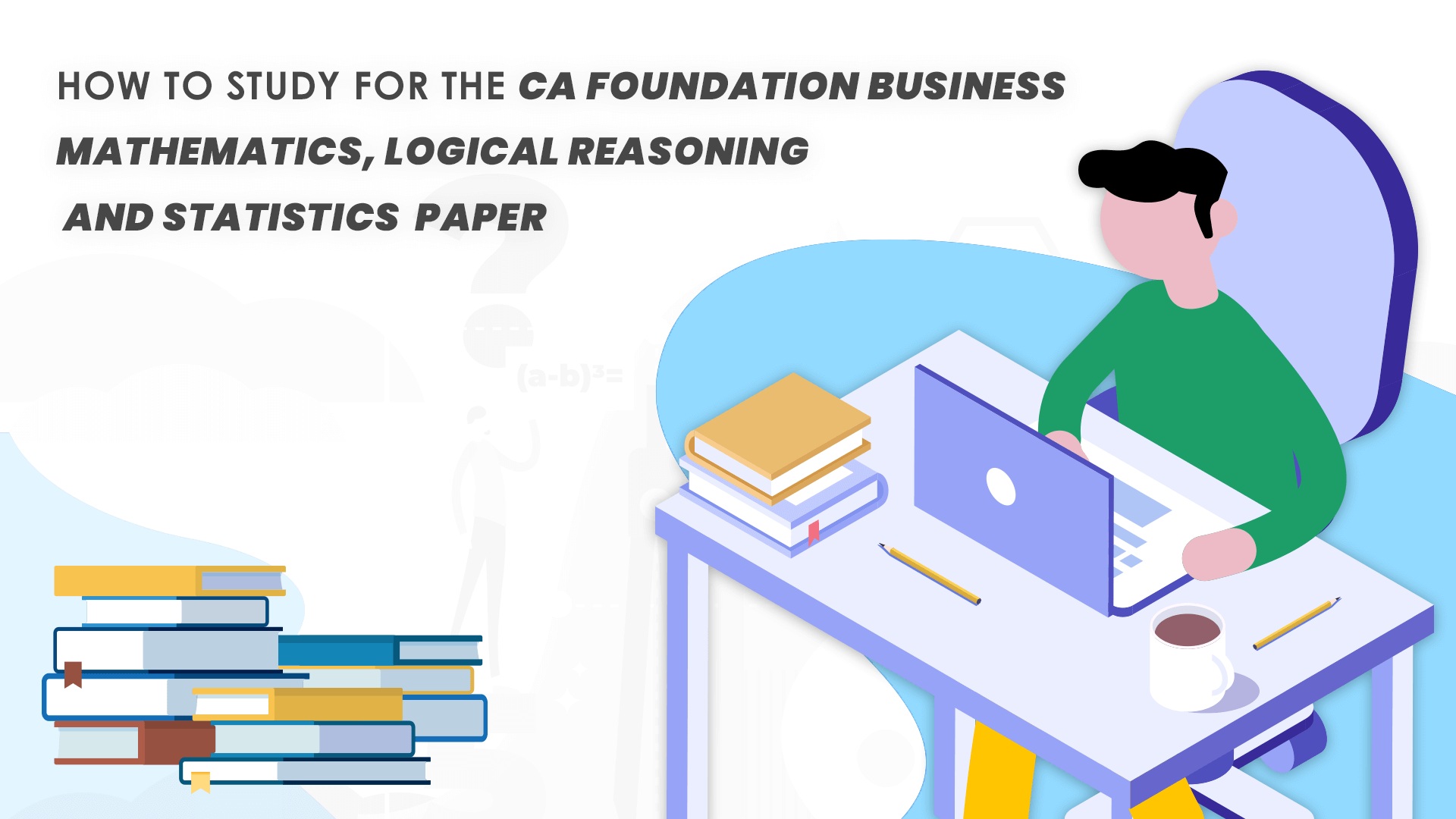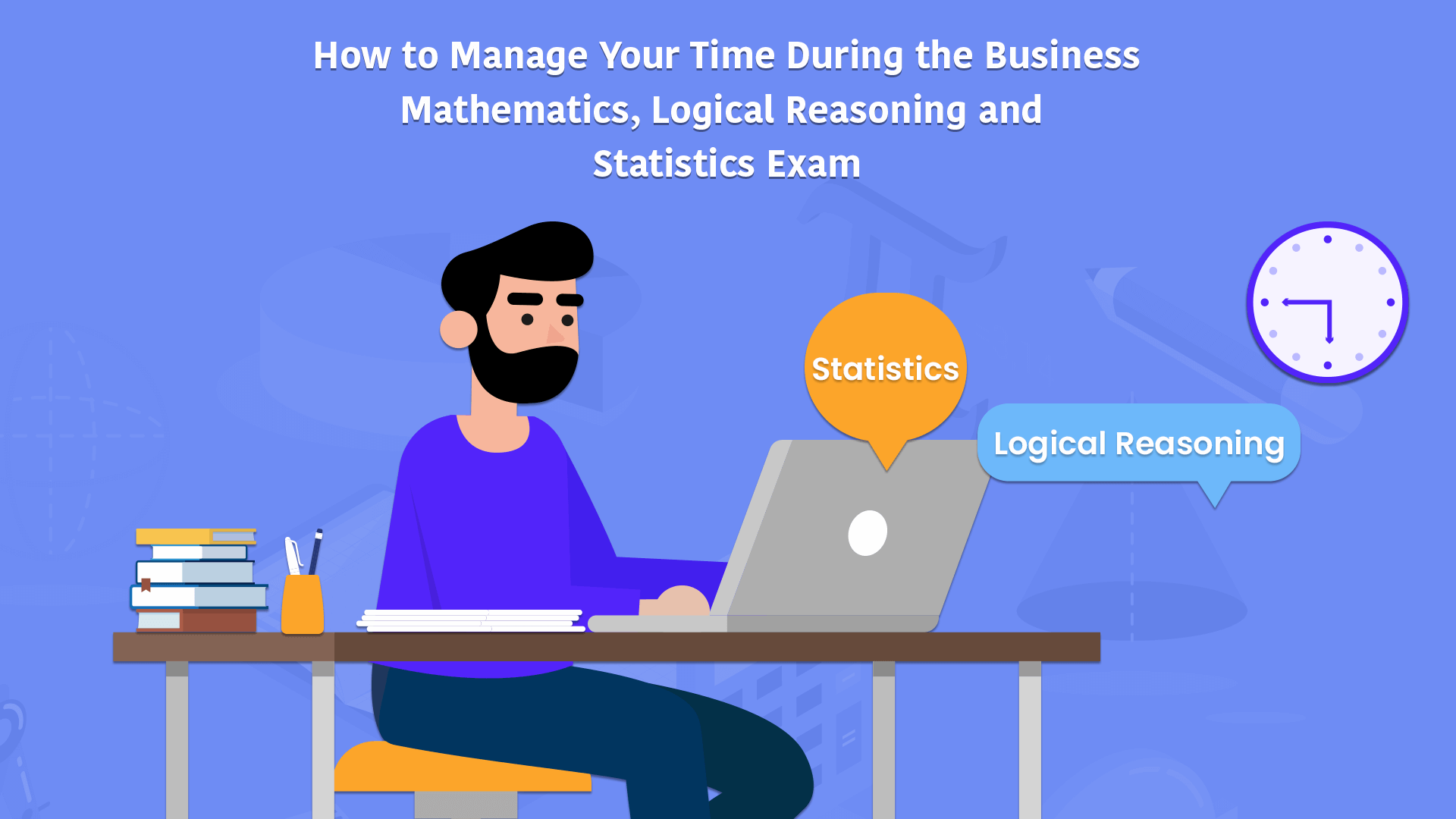Many students find the CA Foundation Business Mathematics, Logical Reasoning and Statistics paper a bit difficult. Although the level is around the PU level, students tend to fear this because most people are told that math = hard. It is also the case that people come into this paper with different backgrounds. Those from a science background find the paper a bit easy (conversely finding the Accounting paper difficult!), while those from a Commerce background (especially those who have not taken any maths) find the paper difficult.
Considering all this, no wonder then, that the paper has a bit of a reputation among CA Foundation students as being “hard.” In this post, we are going to clear this misconception. In fact, by the end, we hope to convince you that this is a scoring subject, and with adequate preparation, you can do really, really, well.
Now, before you do any study, you should know what the format of the paper and syllabus details are.
The paper is divided into three sections: Business Mathematics, Logical Reasoning and Statistics. The Business Mathematics section is worth 40 marks. The Logical Reasoning section is worth 20 marks while the Statistics section is worth 40 marks. The paper itself consists of 100 MCQs each worth 1 mark. There is a negative marking of -0.25 per incorrect answer. If you leave a question blank, you won’t gain or lose any marks.
This format means that you can employ MCQ taking strategies. If you want to know more about how to tackle MCQs, look at our post on
4 tips on how to tack MCQs based on Business Mathematics, Logical Reasoning and Statistics.
Now, it is all very well to know about certain tips to tackle MCQs. But the more important thing to know is how to study for the paper itself! To that end, you should know about the syllabus and various topics.
Here is the list of topics in the Business Mathematics section:
- Ratio and Proportion, Indices and Logarithms
- Equations and Matrices
- Linear Inequalities
- Time Value of Money
- Basic Concepts of Permutations and Combinations
- Sequences and Series – Arithmetic and Geometric Progressions
- Sets, Relations and Functions
- Basic Concepts of Differential and Integral Calculus
Here is the list of topics in the Logical Reasoning section:
- Number Series, Coding, Decoding and Odd Man Out Series
- Direction Sense Test
- Seating Arrangements
- Blood Relations
- Syllogism
And here’s the list of topics in the Statistics section:
- Statistical Description of Data
- Measures of Central Tendency and Dispersion
- Probability
- Theoretical Distributions
- Correlations and Regression
- Index Numbers and Time Series
Now, let us take a closer look at each section in turn, and how to plan out your study.
How to Plan Your Study for the CA Foundation Business Mathematics, Logical Reasoning and Statistics Paper
Section A: Business Mathematics (40 marks)
This section has 40 questions. Of the 3 sections, this section is perhaps the most time consuming to solve. (If you want to know how to manage your time while attempting this paper, we invite you to look at our post on Time Management while attempting Business Mathematics, Logical Reasoning and Statistics.)
Now, to help inform your course of study, it helps to go through and analyse previous years’ question papers. We’ve performed an analysis from mock exams released by ICAI and the November 2018 paper. Here are the results:
CA Foundation Business Mathematics Section Analysis
| Topic |
Mock Exam March 2019 |
Mock Exam April 2019 |
Mock Exam October 2018 |
Mock Exam March 2018 |
November 2018 paper (Real paper; based on memory of students) |
Total |
| Ratio and Proportion, Indices and Logarithms |
6 |
7 |
4 |
4 |
5 |
26 |
| Equations and Matrices |
6 |
4 |
7 |
7 |
5 |
29 |
| Linear Inequalities |
1 |
1 |
4 |
1 |
1 |
8 |
| Time Value of Money |
12 |
13 |
10 |
8 |
13 |
56 |
| Basic Concepts of Permutations and Combinations |
4 |
2 |
4 |
7 |
4 |
21 |
| Sequences and Series – Arithmetic and Geometric Progressions |
3 |
3 |
2 |
4 |
4 |
16 |
| Sets, Relations and Functions |
3 |
4 |
3 |
3 |
4 |
17 |
| Basic Concepts of Differential and Integral Calculus |
5 |
6 |
6 |
6 |
4 |
27 |
Now, it’s important to not pay too much attention to the specific outline of the number of questions. The number of questions from each topic varies from year to year according to the people who set the questions. So, it is important to not neglect any topic. Having said that, you can get a general idea of each topic’s importance when doing this analysis. As you can see, based on this analysis, the greatest number of questions historically comes from the chapter Time Value of Money. The topic with the least weightage tends to be from the chapter linear inequalities. Again, it is very important to emphasise that you should NOT neglect this topic linear inequalities; just be aware of the weightage given.
Now, from
our post on Time Management during this examination, we found that the topic in this section that was most time consuming to solve happened to be Time Value of Money! This correlates very nicely with our paper analysis. Also, this topic happens to be the one that involves a lot of calculation. Calculation takes time. Not only that, most of the questions in the paper come from this topic! So, the importance of this chapter cannot be overstated.
It also shouldn’t be too surprising – concepts learned in this subject are very useful for the aspiring CA. In later levels, i.e.,
CA Intermediate and CA Final, you will build on the concepts learned in this chapter – perhaps more than in any other topic in this paper!
Let’s now move on to an analysis of the next section: Logical Reasoning.
Section B: Logical Reasoning (20 Marks)
This section has 20 questions. This section is somewhat easier than the business mathematics section but not as easy as the statistics section. It will require some effort to solve. Just as in the case of the Business Mathematics section, let’s perform an analysis of some mock exams and previous years’ question papers. The table below shows the results:
It looks like we cannot draw any significant conclusions from this table. Only that it appears that most questions seem to come from the Number series, coding, decoding and odd man out series topic. While it appears that there’s roughly an even distribution of topics from other areas.
And what can we learn from our post regarding
Time Management? Well, we find that the most time-consuming topic in this section happens to be from the chapter syllogism. It looks like we should concentrate our efforts on these two areas first. But again, the usual caveat applies – do not neglect any topic.
You should also be aware that there are no real concepts to be learned from this section. All it takes to do well in this section is to practice, practice, practice. On a variety of different logical skills. It’s only logical!
Let’s move on to the final section of the paper – Statistics.
Section C: Statistics (40 marks)
This is the final section of the paper and it is worth 40 marks. This is perhaps the easiest of the three sections. But although it is the easiest, this section may well be the most important. Because you need to have a solid knowledge of statistics as a CA.
So, let’s look at the statistics of the Statistics section of this paper based on previous years’ question papers and mock exams:
CA Foundation Statistics Analysis
| Topic |
Mock Exam March 2019 |
Mock Exam April 2019 |
Mock Exam October 2018 |
Mock Exam Paper March 2018 |
November 2018 paper (Real paper; based on memory of students) |
Total |
| Statistical Description of Data |
5 |
4 |
5 |
4 |
7 |
25 |
| Measures of Central Tendency and Dispersion |
13 |
12 |
12 |
12 |
12 |
61 |
| Probability |
4 |
6 |
3 |
4 |
7 |
24 |
| Theoretical Distributions |
8 |
6 |
9 |
7 |
4 |
34 |
| Correlations and Regressions |
4 |
6 |
7 |
6 |
5 |
28 |
| Index Numbers and Time Series |
6 |
6 |
4 |
7 |
5 |
28 |
You should be aware that for the purposes of the exam, many of the questions from this section are theoretical. That is, they are just based on knowledge. In fact, from our
Time Management post that we keep talking about, we see that for the Mock Paper March 2019, a little more than 50% of the questions were knowledge-based. While the papers are not generally this skewed (for the real November 2018 paper, the percentage was little less than 50%), our general point stands – many questions are knowledge based. So, if you have good knowledge of statistical theory, you should be able to solve anywhere from 10 – 20 questions from this section within a few minutes! This will save you valuable time! And because of this theoretical nature, this is a scoring section in the overall Business Mathematics, Logical Reasoning and Statistics paper.
As for the topic that you need to pay most attention to? It is clear, from the table, as well as our post on Time Management, focus significant efforts on learning the topic Measures of Central Tendency and Dispersion. This will give you insights into other related topics, as well as gain you most marks. Probability is the topic in this section that involves the most calculation. So, for your study, we suggest put maximum efforts in understanding probability and measures of central tendency and dispersion. This will give you good insights into other topics in Statistics as well. Index Numbers and Time Series are sort of the odd ones out because they are not as closely related to the other topics in this section.
To summarise and paraphrase what we said is that many of the topics in the Statistics section are interrelated. If you gain a handle of the topics of Measures of Central Tendency and Dispersion, Probability you are well on your way to answering about half the questions in this section! Treat Index Numbers and Time Series as topics not significantly related to any other in this part of the paper.
Now that we’ve talked about the topic-wise breakdown of each paper and gained some insights, it’s time to talk about how to make up a study plan of the paper. For the purposes of this discussion, we assume that you have roughly 4 months of study time, and that you are very new to this topic of Business Mathematics, Logical Reasoning and Statistics. Feel free to modify our suggestion based on your needs and background.
A 4-month Study Plan for Business Mathematics, Logical Reasoning and Statistics
Before we talk about our study plan, we suggest that you go over our post on how to create a
study timetable for the CA, CS and CMA exams. Insights gained from that post will serve you in good stead here. You may also want to read about
study tips and strategies to pass tough exams like the CA Course.
Now that you have a rough idea of how to create a study timetable, let’s now look at the overall plan of study for this particular paper.
As we saw, there are three sections to this paper. The mathematics section consists of 8 topics, the logical reasoning section has 5 topics while the statistics section has 6 topics.
Now, you should note that many topics are interrelated and so our plan takes this into account.
We’ll divide the plan into three distinct phases:
- Phase 1: The First Two Months
- Phase 2: The Third Month of Study
- Phase 3: The Fourth and Final Month of Study
Let’s look at each phase in turn.
Phase 1: The First Two Months
In the first two months of study, the plan is quite simple. Go over the topics in order and in detail. In general, you should alternate between learning concepts and practicing problems. That is, learn a concept first, and then practice problems related to that concept. This intermixing of learning and practice is the best way to solidify concepts in your mind.
The table shows the specific plan of action. Note that in the table section, what to concentrate on, we concentrate on the main areas of focus. To get a detailed understanding of the topics involved, and the syllabus, we invite you to go over our post outlining the CA Foundation syllabus.
Study Plan for the CA Foundation Business Mathematics, Statistics and Logical Reasoning Paper – The First Two Months
| Time Period |
Topics to Be Studied |
Main Points to Focus on (and Some Strategies to Solve Questions) [But don’t ignore other parts of the syllabus!] |
| Week 1 |
Ratio and Proportion, Indices, Logarithms; Statistical Description of Data |
Ratio and Proportion, Indices and Logarithms:
- Pay special attention to the laws of indices and logarithms, as well as the connection between them.
Statistical Description of Data:
- Pay close attention to the topics involving frequency distribution, how to present such distributions graphically, and related terms as some of these concepts will come up again in later sub-topics
|
| Week 2 |
Equations and Matrices; Measures of Central Tendency and Dispersion |
Equations and Matrices:
- Make a list of several important geometric formulae from co-ordiante geometry that are useful e.g. how to find the distance between two lines, equation of lines, centroid, points of intersection, Pythagoras theorem, area, perimeter and volume of simple geometric objects, etc.
- Perform calculations centred around special operations related to matrices e.g. inverse, transpose, determinants, minors, cofactors, adjoint matrices, etc. Do these calculations as quickly and accurately as possible
Measures of Central Tendency and Dispersion:
- Understand how measures of central tendency are calculated, and find out how they change with respect to additions/deletions/modifications in the underlying data
- Understand the relationships between the measures
- Understand the deeper meaning behind these measures of central tendency and which measure is appropriate to use depending on the situation
- Understand the meaning of dispersion, classification, and see how they change with modifications to the data
|
| Week 3 |
Linear Inequalities; Direction Sense Test; Seating Arrangements; Blood Relations |
Linear Inequalities:
- Focus on how to set up linear inequalities based on word problems
Direction Sense Test:
- Based on the information given, draw diagrams outlining the path(s) the person(s) has/ve travelled and understand the limitations of data given
Seating Arrangements
- Draw diagrams outlining the seating of people and do NOT make assumptions about how they are seated unless explicitly outlined in the question
Blood Relations:
- Understand the meaning of the terms deeply, e.g., mother-in-law, father-in-law, etc. and draw diagrams to solve problems
|
| Week 4 |
Time Value of Money; Number Series, Coding, Decoding and Odd Man Out Series; Syllogism |
Time Value of Money:
- Understand how the formulas for Compound Interest, Simple Interest, Annuity are derived so that you can easily memorise them
- Pay special attention to when interest is added (start of the year, end of the year, etc.)
- Practice a lot of problems
Number Series, Coding, Decoding and Odd Man Out Series:
- Familiarize yourself with a lot of series. Learn how to recognize how the next number is calculated e.g. sum of two terms, is it in A.P. or G.P. or some combination of both; try simple addition, multiplication of terms, etc.
- Memorise the position of letters in the alphabet, a is in position 1, b in position 2, etc. This will help you solve questions very quickly as many of these questions are based on the position of letters with some modifications
Syllogism:
- Understand the concepts of Syllogism with the aid of Venn diagrams
|
| Week 5 |
Basic Concepts of Permutations and Combinations; Probability |
Basic Concepts of Permutations and Combinations:
- Understand the basic formulas and how they are derived for Permutations and Combinations
- Differentiate whether the question involves you having to perform permutation operations or combinations
- Understand, in depth, how to enumerate all the possibilities without necessarily relying on formulas
Probability:
- Understand how to enumerate the total number of outcomes and the number of possibilities. Take inspiration from the Permutations and Combinations chapter
- Understand how probability is related to distributions (frequency distributions, etc.). You may have to revise a few concepts from the earlier statistics chapters because they are all inter-related
|
| Week 6 |
Sequences and Series – Arithmetic and Geometric Progressions; Theoretical Distributions |
Sequences and Series – Arithmetic and Geometric Progressions:
- Identify very quickly whether the sequence is in geometric or arithmetic progression
- Find out the relations between A.M., G.M. and H.M. as well as how to calculate them
- Understand the connection between G.P. and formulae in the Time Value of Money chapter
Theoretical Distributions:
- Understand how to calculate the basic measures of central tendency for various probability distributions
- Understand the deep connection between probability concepts, measures of central tendency and the theoretical distributions
|
| Week 7 |
Sets, Relations and Functions; Correlations and Regressions |
Sets, Relations and Functions:
- Apart from the concepts outlined in the syllabus, you should understand in depth what a function is, its output, and the concepts of domain and range
- See how concepts in this chapter are related to previous concepts learned, e.g., you may have to use some concepts from the permutation and combination chapter to find out the number of functions from one set to another, and problems of that nature
Correlations and Regressions:
- Understand in depth what it means to have two sets of data correlated with each other and whether there really is a relationship among them.
- Understand that regression is mainly developing a function (mostly linear) that would explain the relationship between two sets of data
|
| Week 8 |
Basic Concepts of Differential and Integral Calculus; Index Numbers and Time Series |
Basic Concepts of Differential and Integral Calculus:
- Understand that differentiation and integration are inverse operations of each other
- Practice a lot of problems related to integration
- Understand the geometric meaning of both integration and differentiation and understand deeply that differentiation is to find the rate of change of the dependent variable with the independent one
Index Numbers and Time Series:
- Understand what is meant by Index Numbers and Time Series
- Realise that Time Series deals with data that changes with time and hence understand that to fully analyse such data, concepts from calculus are needed. This, while not all that important from an examination point of view, will be very important for your understanding of the connection between the concepts.
|
Now, while you are studying for these topics, you should take note of how topics are interrelated. We’ve indicated as such in the table. To elaborate, you should be aware that in the chapter Time Value of Money, the concepts of compound interest, annuity, etc. are in fact special cases of geometric sequences and series! This connection between topics paves the way for a deeper understanding of topics. You should also be aware of how topics across sections are connected. Again, the table above shows some of these connections. Be aware of these while studying.
To elaborate, if you understand concepts related to Permutations and Combinations in the Business Mathematics section, some problems in the Probability chapter from the Statistics section may become easier.
How? This is because in permutations and combinations, you are counting the total number of ways something happens while in probability you are calculating the odds or the probability of some event happening.
We also suggest that you write up a formula sheet containing the list of most important formulas that you need to know. These will include those from geometry as outlined in the table above in the row talking about equations and matrices. They will also include formulae from Statistics (i.e. the various special Probability Distributions, e.g., the normal distribution, Poisson distribution, etc.), sequence and series, time value of money, etc. You should also understand the connection between some of the formula in your sheet. (e.g. see how the time value of money formulae relate to those involving the A.P. and G.P. formulae.)
Keep this formula sheet handy to understand (and memorise!) them. This will save you a lot of time but note that don’t memorise them without understanding how they came about!
Phase 2: The Third Month
This third month involves revision of the most important concepts. At this stage, you should be largely aware of some of the most important connections between topics in a section and between sections! This will really help you look at the paper holistically rather than looking at each topic in the paper individually.
So, based on interrelated concepts, and importance given to each topic from our analysis of mock papers and the like, here is the suggest timeline:
Study Plan for the CA Foundation Business Mathematics, Statistics and Logical Reasoning Paper – The Third Month
| Time Period |
What to Revise |
| Week 1 |
- Time Value of Money
- Seating Arrangements
- Blood Relations
- Number Series, Coding, Decoding and Odd Man Out Series
|
| Week 2 |
- Linear Inequalities
- Syllogism
- Direction Sense Test
- Ratio and Proportion, Indices and Logarithms
- Statistical Description of Data
- Sequences and Series – Arithmetic and Geometric Progressions
- Correlations and Regressions
|
| Week 3 |
- Basic Concepts of Differential and Integral Calculus
- Measures of Central Tendency and Dispersion
- Sets, Relations and Functions
- Index Numbers and Time Series
|
| Week 4 |
- Equations and Matrices
- Theoretical Distributions
- Basic Concepts of Permutations and Combinations
- Probability
|
As you are trying to build connections between topics during this study period, we suggest you employ the method of interleaving as outlined in our post regarding
tips on how to pass. Not only that, this is the period where you work out a lot of questions related to the topics at hand. Hopefully, you’ve already understood all the topics during the 2-month study period; this period is to revise! During this revision period, you may want to draw up a study timetable to organise the study topics suggested. This way, you’ll be able to make good use of the method of interleaving as well as plan out your study day!
Phase 3: The Fourth Month
Here, in this month, you should focus on solving mock exams an




